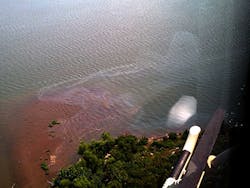EPA is on the scene of an oil spill that occurred Aug. 18 when 3,000-5,000 gallons of diesel fuel was released into the Ohio River from Duke Energy’s Beckjord power plant. Twenty-four hour operations are underway to contain and clean up oil along a 12-mile stretch of the Ohio River immediately upstream from Cincinnati.
“U.S. EPA, the U.S. Coast Guard and Ohio EPA quickly mobilized and are taking a series of steps to minimize the damage this spill does to the Ohio River and surrounding communities,” said U.S. EPA Incident Commander Steven Renninger. “U.S. EPA is on the scene to ensure the leaked oil is contained and cleaned up as quickly and effectively as possible.”
EPA has established a unified command with the U.S. Coast Guard, the Ohio Environmental Protection Agency and Pierce Township. EPA is directing response efforts carried out by Duke Energy. Under the Oil Pollution Act of 1990, U.S. EPA has the responsibility for inland oil spills.
The incident occurred shortly after 11 p.m. on Aug. 18 during a fuel oil transfer at the plant on the banks of the Ohio River in New Richmond, Ohio.
Duke Energy mobilized internal and external resources to respond to the spill, including three vessels on the river that have deployed approximately 2,000 feet of oil-containment booms to contain and help collect the oil.
“We’re working around the clock to rapidly and fully restore the affected section of the Ohio River and coordinating closely with local officials to make sure that drinking water continues to remain safe,” said Lynn Good, president and CEO of Duke Energy. “We take responsibility for the cleanup and the well-being of the communities we serve.”
The oil sheen extends approximately 12 miles from Duke’s plant down the Ohio River toward Cincinnati. The U.S. Coast Guard closed 15 miles of the river to vessel traffic.
As a precaution, the Greater Cincinnati Waterworks and the Northern Kentucky Water District each closed drinking water intakes on the Ohio River. The Ohio River Valley Water Sanitation Commission is conducting water sampling on the river.
About the Author

Sandy Smith
Sandy Smith is the former content director of EHS Today, and is currently the EHSQ content & community lead at Intelex Technologies Inc. She has written about occupational safety and health and environmental issues since 1990.

